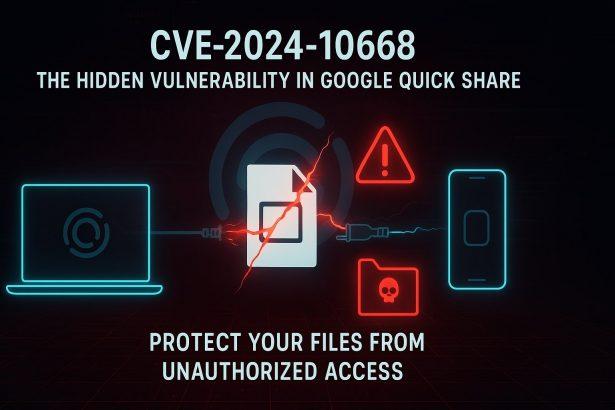In April 2025, cybersecurity researchers uncovered a significant vulnerability in Google’s Quick Share tool for Windows. Quick Share, a popular file-sharing application designed to facilitate seamless data transfers between devices, may seem like a convenient way to share files across different platforms. However, this newly discovered flaw, tracked as CVE-2024-10668, poses a serious security risk, allowing attackers to bypass file transfer approval or even crash the application entirely.
Understanding the CVE-2024-10668 Vulnerability
Quick Share, formerly known as Nearby Share, was developed by Google as a cross-platform tool to make file transfers between Android devices, Chromebooks, and Windows PCs as easy as possible. Think of it as a competitor to Apple’s AirDrop — quick, easy, and designed for seamless transfers. But as with any widely-used tool, vulnerabilities can emerge that compromise the very convenience users enjoy.
The vulnerability identified as CVE-2024-10668 allows attackers to perform two major actions:
Bypassing File Transfer Approval
Quick Share typically requires user approval to accept incoming files. However, researchers discovered that an attacker could manipulate the tool by sending two files with the same payload ID during a single session. Quick Share would only delete the first file, leaving the second file undetected and fully accessible in the Downloads folder. This allows unauthorized files to slip through the cracks and end up on your device without your consent.
Denial-of-Service (DoS) Condition
The second flaw exploits a malformed UTF-8 filename, which causes Quick Share to crash. This results in a DoS attack, essentially freezing or shutting down the application. While it may not allow direct access to your data, it still disrupts the functionality of the tool, leaving users with an unreliable file-sharing experience.
How the Flaws Evolved
It’s important to note that these vulnerabilities aren’t entirely new. In August 2024, SafeBreach Labs identified several security flaws within Quick Share, tracked as CVE-2024-38271 and CVE-2024-38272, which could be exploited to run arbitrary code on Windows devices. Following responsible disclosure, Google issued patches to address the issues. However, the new research suggests that some of the vulnerabilities remained unpatched or only partially fixed, leading to the reemergence of the problems.
What this teaches us is a valuable lesson about cybersecurity: simply patching over a problem doesn’t always eliminate it completely. If the root cause isn’t addressed thoroughly, vulnerabilities may persist in more subtle forms. This case serves as a reminder that post-patch testing and continuous vigilance are essential to ensure that software tools are genuinely secure.
What You Can Do to Protect Yourself from CVE-2024-10668
So, how can you protect yourself from these vulnerabilities in Quick Share, as well as similar security issues in other file-sharing tools? Here’s a list of actionable steps you can take to secure your data and ensure that you aren’t leaving your device open to malicious attacks:
Keep Your Software Updated
One of the easiest and most effective ways to protect yourself is by ensuring that your software is up to date. Google has already released a patch to fix the vulnerability in Quick Share for Windows version 1.0.2002.2. Regularly check for updates to all your software, especially security-related tools like Quick Share, to make sure that any newly discovered vulnerabilities are addressed as soon as possible. Enable automatic updates whenever possible to ensure you never miss a critical security patch.
Use Reputable File-Sharing Services
While Quick Share is widely used, it’s important to be selective about the tools you use for file sharing. Opt for file-sharing platforms that are well-known for their security measures and have a solid track record of keeping user data safe. Look for features like end-to-end encryption, which ensures that your files are securely transferred without being intercepted or tampered with.
Additionally, choose services that are compliant with data privacy regulations, such as the General Data Protection Regulation (GDPR) in the EU or California Consumer Privacy Act (CCPA) in California. These regulations set standards for how companies handle your personal data, offering an extra layer of protection.
Enable Multi-Factor Authentication (MFA)
Multi-factor authentication (MFA) adds an extra layer of security to your accounts by requiring more than just a password to gain access. While it’s a common security measure for online services, it’s often overlooked for file-sharing tools. If Quick Share or any other file-sharing platform supports MFA, make sure to enable it. Even if a malicious actor manages to exploit a vulnerability, they’ll need additional authentication to gain access to your data.
Be Cautious with Shared Links
Another security precaution is to be cautious with how you share files. When sending files, always set expiration dates for shared links to ensure that they don’t remain accessible indefinitely. This minimizes the risk of unauthorized access to your files after you’ve shared them. Avoid using public sharing links unless absolutely necessary, as these links can easily be accessed by anyone with the URL.
Moreover, always verify the recipient before sending any sensitive information. A simple message to confirm that they are expecting the files can help prevent mistakes and unauthorized transfers.
Monitor File Access and Activity
For those using Quick Share in professional or sensitive contexts, it’s a good idea to monitor file access and set up alerts for any unusual activity. This allows you to quickly detect when a file has been accessed without your knowledge or if an unexpected file transfer occurs. Many file-sharing services, including cloud storage platforms, offer audit logs and access tracking features to help you stay informed.
Educate Yourself and Others
Cybersecurity isn’t just about tools and settings; it’s also about awareness. Make sure that everyone who uses file-sharing tools in your environment — whether at home or in a workplace — is aware of security best practices. Educate them on the risks of transferring files without approval, the importance of keeping software updated, and how to identify phishing attempts that could lead to malicious file transfers.
Conclusion: A Wake-Up Call for File-Sharing Security
The CVE-2024-10668 vulnerability serves as a stark reminder that no software, no matter how popular, is invulnerable to security issues. This flaw, along with others discovered in Quick Share, highlights the need for ongoing vigilance and robust security practices when it comes to file-sharing tools.
As we continue to rely on tools like Quick Share for convenience and efficiency, it’s essential to take the necessary steps to protect our data. By keeping software up to date, using trusted services, enabling MFA, being cautious with file sharing, and staying informed, we can ensure that our devices remain secure against potential threats.
Security is a shared responsibility. While companies like Google must address vulnerabilities promptly, users also play a crucial role in safeguarding their own data. By following the steps outlined above, you can minimize the risk of falling victim to cyberattacks and enjoy a safer digital experience.




